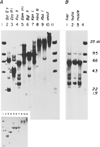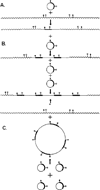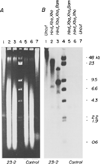Somatic expression of herpes thymidine kinase in mice following injection of a fusion gene into eggs
- PMID: 6276022
- PMCID: PMC4883678
- DOI: 10.1016/0092-8674(81)90376-7
Somatic expression of herpes thymidine kinase in mice following injection of a fusion gene into eggs
Abstract
A plasmid, designated pMK, containing the structural gene for thymidine kinase from herpes simplex virus (HSV) fused to the promoter/regulatory region of the mouse metallothionein-I gene, was injected into the pronucleus of fertilized one-cell mouse eggs; the eggs were subsequently reimplanted into the oviducts of pseudopregnant mice. The first experiment produced 19 offspring, one of which expressed high levels of HSV thymidine kinase activity in the liver and kidney. pMK DNA sequences were detected in equal amounts in several tissues of the expressing mouse as well as in three mice that did not express HSV thymidine kinase activity. In all cases, several copies of the pMK plasmid were tandemly duplicated and integrated into mouse DNA. It appears as though multiple copies of the intact plasmid were fused by homologous recombination either before or after integration at a single site in the mouse genome. The overall efficiency of obtaining somatic expression of thymidine kinase in experiments performed to date is about 10% (4/41), and twice this number have integrated pMK DNA. This procedure not only provides a means of introducing new genes into mice, but it will also be a valuable system for studying tissue-specific regulation of gene expression.
Figures




 ). (A) A single plasmid DNA molecule recombines (either by homologous or nonhomologous recombination) with mouse DNA to give a single integrated plasmid. The junction between mouse and plasmid sequences might occur at any site in both plasmid and mouse DNAs. Digestion with either of the two enzymes whose sites are shown would be expected to generate two products, neither of which would be likely to be the same size as linear pMK DNA. (B) After the initial integration event, a number of subsequent events could occur involving homologous recombination of additional copies of pMK into those already integrated, giving rise to a tandem repetition of the integrated pMK sequences. Digestion with either enzyme would generate several copies (three as drawn) of full-length linear pMK molecules, plus single copies of two new junction fragments. (C) Several copies of the plasmid could homologously recombine with one another to generate a tandemly repetitive plasmid, which would then recombine with mouse DNA, again generating a tandemly repeated integrated plasmid. Restriction enzyme analysis would generate the same products as model B.
). (A) A single plasmid DNA molecule recombines (either by homologous or nonhomologous recombination) with mouse DNA to give a single integrated plasmid. The junction between mouse and plasmid sequences might occur at any site in both plasmid and mouse DNAs. Digestion with either of the two enzymes whose sites are shown would be expected to generate two products, neither of which would be likely to be the same size as linear pMK DNA. (B) After the initial integration event, a number of subsequent events could occur involving homologous recombination of additional copies of pMK into those already integrated, giving rise to a tandem repetition of the integrated pMK sequences. Digestion with either enzyme would generate several copies (three as drawn) of full-length linear pMK molecules, plus single copies of two new junction fragments. (C) Several copies of the plasmid could homologously recombine with one another to generate a tandemly repetitive plasmid, which would then recombine with mouse DNA, again generating a tandemly repeated integrated plasmid. Restriction enzyme analysis would generate the same products as model B.

References
-
- Bradford M. A rapid and sensitive method for quantitation of microgram quantities of protein utilizing the principle of protein-dye binding. Analyt. Biochem. 1976;72:248–254. - PubMed
-
- Brinster RL. Cultivation of the mammalian embryo. In: Rothblat G, Cristofala V, editors. Growth, Nutrition and Metabolism of Cells in Culture. Vol. 2. New York: Academic Press; 1972. pp. 251–286.
Publication types
MeSH terms
Substances
Grants and funding
LinkOut - more resources
Full Text Sources
Other Literature Sources
Molecular Biology Databases

